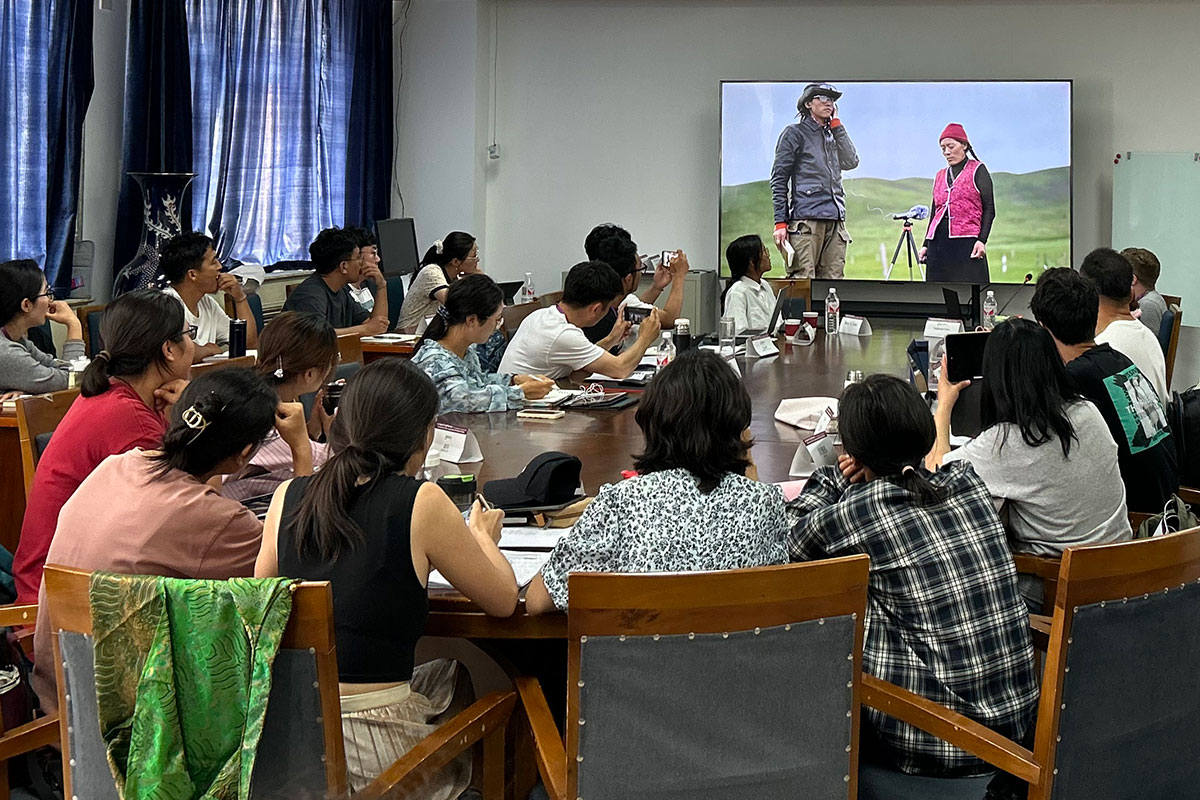Nine years after participating in the first Sino-Tibetan Language Research Methodology Workshop, an initiative by the Center for Folklife and Cultural Heritage and Nankai University, Palmo Gyal teaches Tibetan studies at Qinghai Minzu University in western China.
Chimed Lhamo, another workshop alum, is pursuing her PhD in linguistics at Fudan University. She has focused her research on Queyu, her mother tongue and one of dozens of endangered Sino-Tibetan languages that scholars and students across China are working to revitalize.
The Tibetan Plateau is home to a rich, complex language landscape in southwestern China. While Ü-Tsang, Amdo, and Khams are the dominant dialects among Tibetans, at least fifty other Tibetan languages and thirty-eight minority, non-Tibetic languages exist. Urbanization, language shift, and decreased intergenerational language transmission have endangered smaller Tibetan dialects—along with the traditional knowledge and practices they carry.
Two thousand miles from the Tibetan Plateau is the coastal Chinese city of Tianjin, home to the fruits of this international collaboration. As a component of the Center’s Language Vitality Initiative, the Sino-Tibetan Language Research Methodology Workshop was founded on a commitment to language maintenance and a belief in its potential to reverse cultural erosion. Today, the workshop, as well as the discussion and research forum it includes, composes the only academic institute in China dedicated solely to Tibetan linguistic training. While the Smithsonian’s involvement in the workshop concluded this year, organizers in China are planning to host the next iteration in 2026.

In 2014, the Smithsonian’s Office of Global Affairs launched a project to support collaborations between Smithsonian staff and ethnic Tibetans in China. Mary Linn had recently joined the Center’s curatorial staff, and while her background was in Native American linguistics, the project offered an opportunity to exchange with others working in language promotion. Linn recruited predoctoral linguistics student Zoe Tribur and post-doctoral folklorist Timothy Thurston to assist.
Linn and her team initially struggled to find a partner institution in China. Then, in 2015, Tribur noted that Tibetan linguistics professor Yeshes Vodgsal Atshogs was visiting the University of Maryland from Nankai University in Tianjin. The team met Atshogs for dinner in College Park, and they connected over shared ambitions in language education.
Nankai University, or NKU, an institution with a long commitment to minority languages, emerged as an ideal partner for the Smithsonian. They signed a memorandum of understanding in 2016, and the workshop launched that year.
Since then, the workshop has instructed 261 students. The curriculum supports multilingualism in Tibetan areas through lessons in descriptive and sociolinguistics, cultural documentation, software, and more. Interested students apply to the program through NKU. Students must speak Chinese because it is the common language of the workshop, but they do not need to be proficient in any Tibetan dialects.
“They don’t have to speak the language of their village or area, but they do have to want to contribute something to it,” Linn explains.
Once selected for the program, students live in the NKU dorms for two weeks. The workshop appeals to students across China, who often spend several days traveling to Tianjin. “Some of them hitchhiked from mountaintops, then caught a bus to Beijing,” Linn says. “It was amazing.”
Students learn under NKU faculty and visiting lecturers from Europe and the United States. They also attend a linguistics conference, which introduces them to prominent scholars in the field. Those newer to linguistics may struggle to understand the complex topics discussed, but they’re “getting exposed,” Linn says. In 2024, three former workshop students were invited to give talks at the forum.
Six months after each workshop concludes, students complete a survey about their experience. Often, students report that they have shared what they learned with their communities—broadening the workshop’s impact even further. Although it takes generations to reverse language shift—from a minority to a dominant language—over its nine years, the institute has made a clear and important influence.
In the survey, one Tibetan student wrote that they had struggled to find people enthusiastic about mother-tongue research in their hometown. This left them questioning the value of their studies. But attending the workshop renewed their confidence in the work they were doing. The student would go on to pursue a PhD in linguistics.
“In the past, I thought that my mother tongue was not as useful as others, but after this workshop, I’ve found many interesting things about my language,” another student wrote. “It is special and valuable. I am also aware of the urgency and importance of keeping my language alive.”
When a language loses value with its own speakers—called “prestige” in revitalization work—it is harder to reverse its shift. One of the workshop’s goals is to connect minority-language speakers with peers who believe in the importance of their language and the urgency of their studies. Within these communities, there are people grieving and celebrating over lifetimes of language vitality work.
A second participant echoed the importance of finding supportive, passionate people in the field. “When studying alone, I often come across problems that cannot be solved on my own,” they said. “However, when studying together, we can communicate and discuss things that help solve these problems.”
On the survey, a third participant expressed their gratitude for their newfound community of colleagues and scholars. “There is no greater happiness than working together with friends,” they said.
Linn agrees.
“This year, in my introduction speech, I said that we are all family,” she said. “And the place resounded with clapping, from the professors, the dean, everybody. It is all about the people. It is about reaching across seemingly insurmountable barriers and working together.”

Ella Ryan is a writing intern at the Center for Folklife and Cultural Heritage and a senior at William & Mary, studying history and creative writing.


